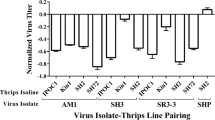Abstract
Symptomatically distinct isolates of potato leaf roll virus were transmitted from White Rose to Russet Burbank potato by aphids and by grafting, from White Rose potato toP. floridana by aphids, and fromP. floridana toP. floridana by aphids. Isolates from White Rose potato generally produced stable and characteristic secondary leaf roll symptoms (but not primary leaf roll symptoms) when transmitted to Russet Burbank potato but variable symptoms when transmitted toP. floridana. Isolates from two of the latter plants with moderate and severe symptoms generally incited stable and characteristic symptoms when transmitted to otherP. floridana plants. The stable symptoms produced by each of these isolates were not modified by infestingP. floridana plants with varying numbers of viruliferous aphids.
The results obtained in this study corroborate previous evidence for the existence of strains of potato leaf roll virus. It is suggested that certain White Rose potato plants contained mixtures of leaf roll virus strains. Furthermore, it is postulated that these mixtures were at least partially separated by “natural” selection following transmission toP. floridana. This mechanism provides an explanation for the stable symptoms produced by isolates transmitted fromP. floridana toP. floridana.
Resumen
Aislamientos del virus de rosca de hoja sintomaticamente distintos han sido transmitidos de la papa White Rose a la papa Russet Burbank por áfidos y por injerto, de la papa White Rose aP. floridana por áfidos, y deP. floridana aP. floridana por áfidos. Aislamientos de la papa White Rose produjeron generalmente síntomas de una estable y característica rosca de hoja secundaria (pero no de rosca primaria) cuando eran trasmitidos a la pnpa Russet Burbank, pero produjeron síntomas variables cuando fueron transmitidos aP. floridana. Aislamientos obtenidos de dos de estas últimas plantas con síntomas moderados y severas generalmente incitaron estables y característicos síntomas cuando fueron transmitidos a otras plantas deP. floridana. Los síntomas estables producidos por cada uno de estos aislamientos no fueron modificados infestandoP. floridana con números diferentes de áfidos virulíferos.
Los resultados obtenidos en este estudio confirman la evidencia anterior de la existencia de cepas de virus de rosca de papa. Se sugiere que ciertas plantas de la papa White Rose contenían mezclas de cepas de virus de rosca de papa. Además se postula que estas mezclas fueron, almenos en parte, separadas por selección “natural” después de la transmisión aP. floridana. Este mecanismo da una explicación de los síntomas estables producidos por los aislamientos transmitidos deP. floridana aP. floridana.
Similar content being viewed by others
Literature Cited
Harrison, B. D. 1958. Ability of single aphids to transmit both avirulent and virulent strains of potato leaf roll virus. Virology 6: 278–286.
Hoagland, D. R. and W. C. Snyder. 1933. Nutrition of strawberry plant under controlled conditions: (a) effects of deficiencies of boron and certain other elementts: (b) susceptibility to injury from sodium salts. Proc. Amer. Soc. Hort. Sci. 30: 288–294.
Holmes, F. O. 1965. Genetics of pathogenicity in viruses and of resistance in host plants. Advan. Virus Res. 11: 139–161.
Hoyman, W. G. 1962. Importance of tuber eye position when indexing for the leafroll virus. Amer. Potato J. 39: 439–443.
Kassanis, B. 1952. Some factors affecting the transmission of leaf-roll virus by aphids. Ann. Appl. Biol. 39: 157–167.
MacCarthy, H. R. 1963. Instability of symptoms of potato leaf roll virus. Phytopathology 53: 1161–1163.
Rozendaal, A. 1952. Demonstration of experiments with potato viruses. Proc. Conf. Potato Virus Diseases, Wageningen-Lisse, 1951, 63–65.
Webb, R. E. 1955. A new strain of potato leaf roll virus. Amer. Potato J. 32: 173–179.
Webb, R. E., R. H. Larson and J. C. Walker. 1952. Relationships of potato leaf roll virus strains. Wisconsin Agr. Exp. Sta. Res. Bull. 178. 40 p.
Webb, R. E., E. S. Schultz and R. V. Akeley. 1955. Some variations in symptomatology and transmisson of leafroll in potato. Amer. Potato J. 32: 60–66.
Wright, N. S. and H. R. MacCarthy. 1963. Expression and detection of leaf roll virus strains in potato. Amer. Potato J. 40: 154–162.
Wright, N. S., H. R. MacCarthy and E. F. Cole. 1967. Detection and control of mild strains of potato leaf roll virus. Amer. Potato J. 44: 245–248.
Author information
Authors and Affiliations
Rights and permissions
About this article
Cite this article
Chiko, A.W., Guthrie, J.W. An hypothesis for selection of strains of potato leaf roll virus by passage through Physalis floridana. American Potato Journal 46, 155–167 (1969). https://doi.org/10.1007/BF02872358
Accepted:
Issue Date:
DOI: https://doi.org/10.1007/BF02872358




